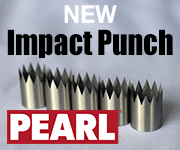Featured Stories
-
The Rise of Flexible Packaging: Why Stand-Up and Flat-Bottom Pouches Are Replacing Rigid Containers
The packaging industry is undergoing a fundamental shift as brands increasingly move away from rigid containers in favor of stand-up and... -
-
Elevating Pouch Manufacturing with Pearl Technologies' Cutting-Edge Solutions
For manufacturers seeking efficiency, precision, and safety in pouch production, Pearl delivers unmatched innovation across three standout...
News | New Products
-
FPA Testifies at U.S. House Subcommittee Hearing on Recycling and Economic Development
Felton Urges Federal Support for Investment in Recycling Infrastructure, Innovation, and National Labeling Standards to Help Achieve Full Circularity for Flexible Packaging and Films
-
Hybrid Software’s ColorLogic Releases ZePrA 13
Smarter, Faster, More Automated Color Management
-
Nobelus Launches Films for Digital Embellishments
Label and Flex Pack Film Supplier Releases Coated Finished for Value-Add Embellishments
-
PACKZ 11 Launches with Industry-First RIP Integration
Plus extended CF2 format and automated support for 2-D Barcodes as Required by the Sunrise 2027 Initiative
-
Double E Group Acquires CAC, Further Enhancing its Strength in the Global Converting Industry
Double E Group, a global leader in converting components and web handling technology, has announced its acquisition of Converter Accessory Corporation (CAC)
-
Nobelus Launches Entry-Level Komfi® Thermal Laminator
FINISHING SOLUTIONS SUPPLIER OFFERS NEW JUNIOR 52 LAMINATING SYSTEM
-
Double E Group Mourns the Loss of Founder and Converting Industry Pioneer, Richard Edward Flagg
Double E Group announces with profound sadness the passing of its founder, Richard Edward “Ed” Flagg, on June 23, 2025. He was 85.
Expert Advice
OSHA'S New Ergonomics Rule Covers a Lot of Ground
- Published: January 01, 2001, By Sheila A. Millar, Attorney-at-Law, Keller and Heckman LLP
The Occupational Safety and Health Administration (OSHA) recently issued its much-debated final rule on ergonomics. The rule is designed to reduce the frequency and severity of musculoskeletal disorders (MSDs) caused, contributed to, or significantly aggravated by acute and/or chronic workplace exposure to the risk factors of awkward posture, contact stress, force, repetition, and vibration.
The rule is sweeping--covered employers generally include all private employers outside the construction, maritime, agriculture, railroad, and mining sectors.
Many industry members have criticized the breadth, scope, and compressed compliance implementation schedule. Legal challenges to the final rule already have been filed, and options for Congressional rescission, a courtordered stay, or intervention by the next Administration continue to be explored.
If these legal strategies fail, converters, their customers, and their suppliers will have to initiate MSD compliance strategies in a very short period of time.
The six core elements of the rule are MSD hazard information and reporting; management leadership and employee participation; hazard analysis and control; training; medical management; and program evaluation.
Compliance obligations for those not claiming grandfather status may be described conveniently in terms of three phases.
In Phase I, which must be completed no later than 10/15/01, covered employers must provide all employees with information on MSD hazards and the reporting of MSDs and MSD signs and symptoms. They also must do whatever else is necessary to comply with the requirements of Phase II as they come due.
Under Phase II, and no later than 10/16/01, they must promptly investigate each employee report of an MSD or an "MSD sign" or "MSD symptom" to determine whether and to what extent the following core requirements of the rule are triggered: management training and procedures, employee participation, medical management, hazard analysis, and initial hazard controls.
In Phase III they must implement permanent hazard controls and a program evaluation.
Phase II core requirements kick in when an employee experiences an "MSD Incident" in a job with exposures to MSD risk factors above the "Action Levels" specified in the rule. An "MSD Incident" is a work-related condition resulting in days away from work, restricted work, medical treatment beyond first aid, or an MSD sign or symptom lasting seven days from the initial report. An "MSD Sign" includes decreased range of motion; deformity; decreased grip strength, and a loss of muscle function. "MSD Symptoms" include pain; numbness; tingling; burning; cramping; and stiffness.
OSHA has established specific action levels for different activities or motions, including repetition, force (lifting, pushing, pulling, or gripping), awkward postures, contact stress, and vibration. If the relevant action level is exceeded for an MSD incident, the Phase II core requirements are triggered and must be completed within specific time frames.
Permanent controls must be instituted two years after a determination that an action level has been exceeded, or Jan. 18, 2005, whichever is later. The rule includes specific recordkeeping and records retention requirements. OSHA estimates that 37% of workers will have exposures above the action levels.
While OSHA has offered a "grandfathering" option in the rule, the extent to which an existing ergonomics program will be deemed to comply is unknown. Companies are wrestling with whether training should be done on a site-wide basis, or the initial focus should be on problem jobs only. Employers also are faced with determining which, if any, of the "safe harbor" analytical tools OSHA has identified are suitable for job analysis.
Based on OSHA's estimates, 7 million jobs--some 19,000 jobs per day--will require some sort of fix in the first year. Smart employers are beginning the planning process now.
Sheila A. Millar, a partner with Keller and Heckman LLP, counsels both corporate and association clients. Contact her at millar@khlaw.com.






















